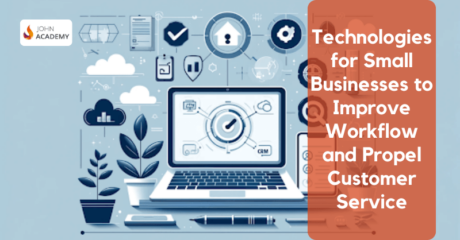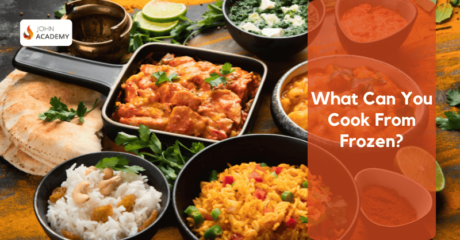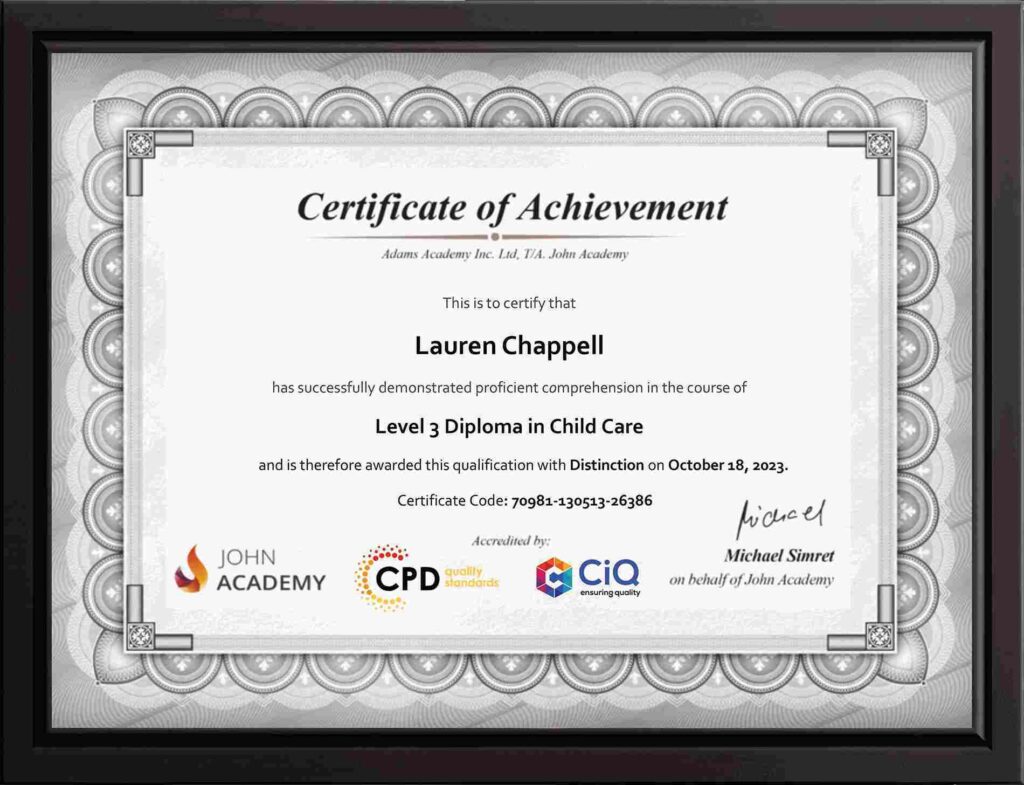
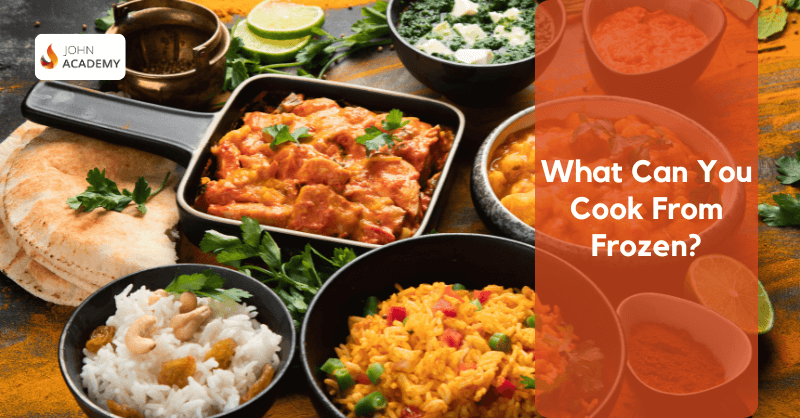
Cooking frozen food is not only a great time saver but an excellent way to minimise food waste while indulging yourself in delicious meals. However, not all food is safe to cook frozen. You can directly toss some frozen food in the pan or oven while others need thawing.
So, which food can be cooked from frozen? Which food needs defrosting? Or how long does it take to cook frozen food? You will find all the answers in our blog. It will give you all the information you need to tackle your next frozen culinary adventure!
But remember to prioritise Food Hygiene, Health And Safety!
In this article -
What Foods Can Be Cooked from Frozen?
When it comes to cooking frozen food, the possibilities are endless. You can cook anything from meat to fresh vegetables or cooked meals from the frozen state. Here is a list of common food items that can be cooked from frozen.
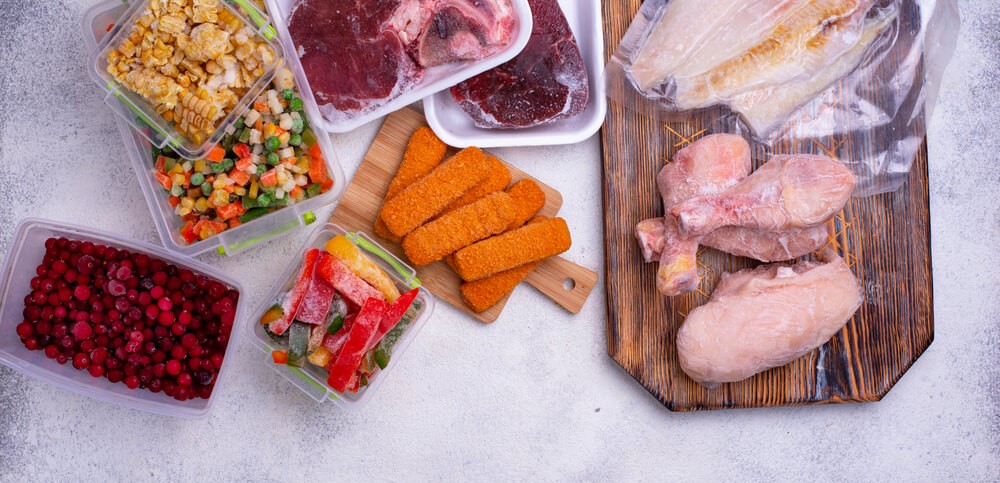
Along with these, there are many other foods that can be cooked from frozen. For a better understanding of what can be cooked from frozen and what can’t be, stick to our blog.
Set your freezer to 0 °F (-18 °C) or lower to ensure food is frozen solidly and safe to eat later.
Expert Tip! Tweet
Can I Cook Frozen Beef?
Absolutely. There are no problems in cooking beef products straight from frozen. However, we suggest you cook frozen beef that’s already sliced or diced because small pieces of meat take less time to cook.
To cook frozen beef, you will need additional cooking time. In addition, it is important to ensure the meat reaches 70 °C and hold this temperature for at least 2 minutes. This will kill all the bacteria that may lurk inside.
Can I Cook Frozen Chicken?
Yes, you can cook frozen chicken. As you already know, meat products can be cooked from frozen, and chicken is no different. Chicken cut into small pieces can go straight to the cooking process. When you buy frozen diced or sliced chicken from the supermarket, it’s best to follow the instructions on the label for food safety.
On the other hand, if you want to cook big pieces or whole chicken or any kind of bird, it’s wise to defrost them first. The safe way is to defrost the chicken in the refrigerator. It is not mandatory to defrost the chicken, but it is useful for getting better results.
When you cook whole chicken or large portions, it may still be undercooked on the inside. The outer layers will get cooked, but the icy inside will not. As a result, the chicken will not taste good and become unsafe to eat, as harmful bacteria may still exist.
On top of that, you have to increase the cooking time for frozen chicken. It requires double the amount of cooking time. That’s why it’s better to defrost and cook the chicken. While cooking chicken, always check if the inside temperature reaches 70 °C and lasts a minimum of 2 minutes. This step is vital to kill the harmful germs and bacteria hiding inside the meat.
Can I Cook Frozen Steak?
Cooking frozen steaks is completely fine. However, if the ice comes in contact with hot oil or butter, it will splatter. So, remove the icy crystals before putting the steak on a pan or grill. Once the outer surface is all brown and juicy, place your steak inside the oven to cook the inside. Select the oven cooking time according to the thickness and portion of the steak.
Remember, stack your steaks individually instead of putting them in a large chunk when you freeze them. Keeping them separate will help you easily take them out and cook. When they are in large chunks, you will find it difficult to separate the frozen pieces unless you defrost them.
Can I Cook Frozen Lamb?
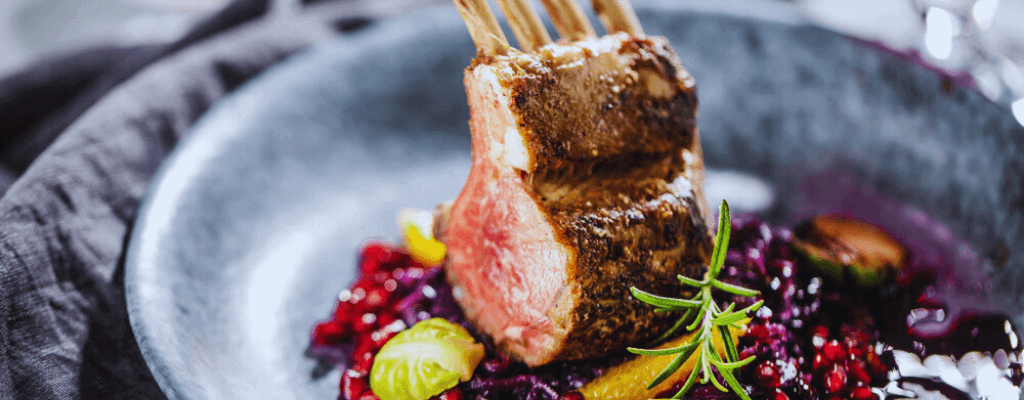
Frozen lamb can be used to make delicious lamb dishes. However, it takes longer to cook frozen lamb, so make sure you have extra time. In addition, use sliced or diced small pieces. This is important, as smaller portions receive the heat evenly and are cooked quickly.
However, if you are planning to cook big chunks like the rack or legs, deforesting is a must. If you cook a larger portion straight from the freezer, it will be undercooked and unsafe to eat. On top of that, while trying to cook it properly, you may overcook it and ruin the taste.
Can I Cook Frozen Salmon?
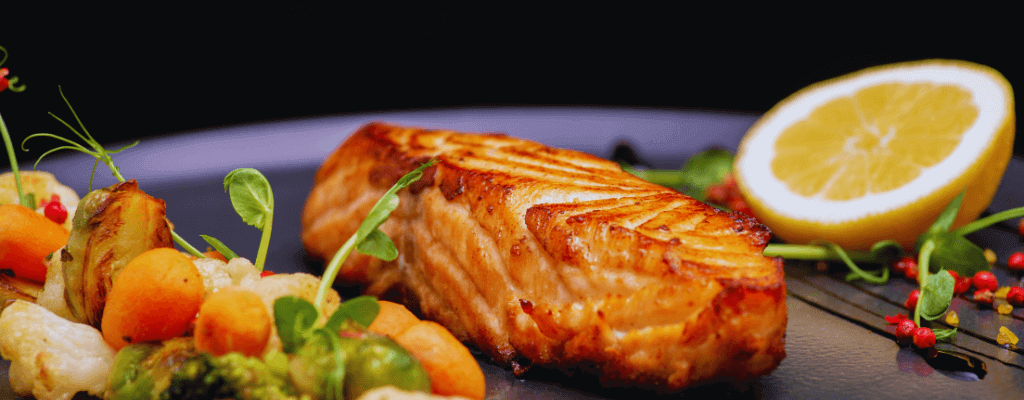
As you already know, fish can be cooked from frozen. So, cooking salmon straight from frozen like any other fish is perfectly safe. You can cook the salmon in any method you want: boiling, grilling, or frying.
However, the cooking time will depend on the portion size and your recipe. Also, remember that frozen food takes longer to cook. Therefore, adjust your cooking time and make sure it reaches the safe internal temperature. Once you are sure it’s properly cooked, add some more seasoning if needed and dig in!
Can I Cook Frozen Mince?
You can cook mince from frozen and make tasty meals for yourself or your loved ones. For cooking mince, you have to put it in a pan at a low temperature. When the ice melts, break down the big chunks. One your mince is completely defrosted, turn up the heat and cook the mince as you like. Usually, it takes around 10–15 minutes to cook frozen mince properly.
Can I Cook Frozen Prawns?
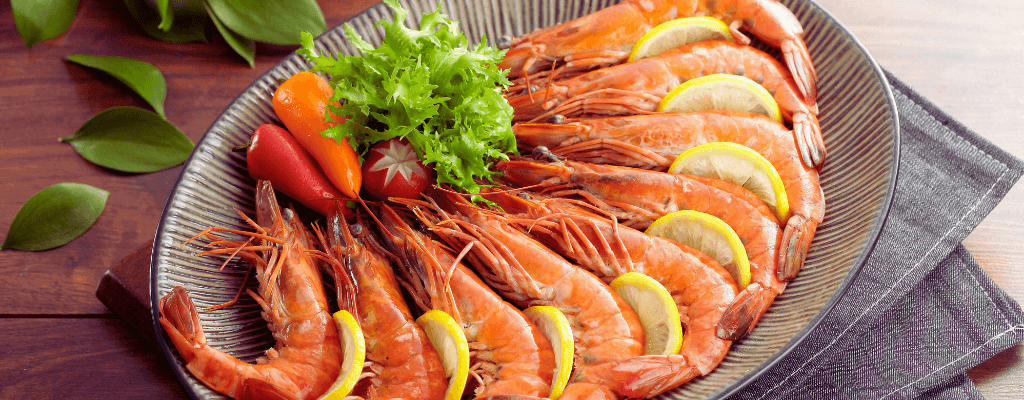
Prawns can be cooked or frozen, and there are no safety issues with them. However, when you cook prawns from frozen, you need extra cooking time to melt the ice. This can cause overcooking of the prawns and make them chewy.
It is better to defrost the prawns in the refrigerator before cooking than to have a chewy, hard texture. You could also use cold running water instead of the refrigerator for defrosting.
Can I Cook Frozen Meatballs?
Whether you can cook meatballs frozen, depends on how you purchase them. Meatballs that were bought frozen can be cooked straight away. You may have to spend some extra cooking time to cook the inside properly. Check the packaging for instructions and follow them for the best results.
On the other hand, if you freeze your meatballs after buying them, you need to thaw them. Once they are defrosted, you can cook them as you like. Frozen or defrosted, no matter what meatballs you cook, make sure they are piping hot from the inside when you are serving them. Bacteria can grow inside raw meat; that’s why it’s important to cook them thoroughly.
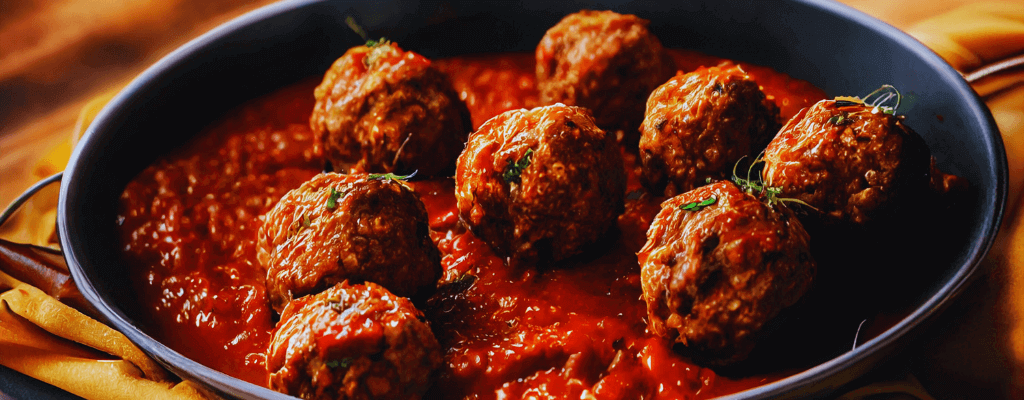
Can I Cook Frozen Fish?
Fish is mostly cooked from frozen. You can cook frozen fish in many ways, such as grilling, frying, steaming, etc. Whichever method you choose, wash the fish with cold water before you start cooking. Washing the fish helps clear the icy crystals and allows the outer layer to defrost.
Some recipes also suggest cooking frozen fish for longer than fresh fish. When you are cooking fish straight from frozen, the inside stays icy. Therefore, it takes more time to reach the safe internal temperature of 63 °C or above. So, cook the fish for an extra few minutes and check it with a thermometer before taking it out.
Can I Cook Frozen Sausages?
Cooking frozen sausages is a common practice. You can freeze almost all types of sausages. Read the label to check if you need to defrost the sausage before you cook the sausages. If you get your sausages from the butcher, ask them whether you have to defrost them or not.
You can cook the sausages however you like, but make sure they reach the internal temperature of 70 °C. It is also important to keep at that temperature for at least 2 minutes. This step is important for killing the bacteria inside, especially for meat sausages. The cooking time will depend on the method; however, it usually takes 15 minutes to cook the sausages fully.
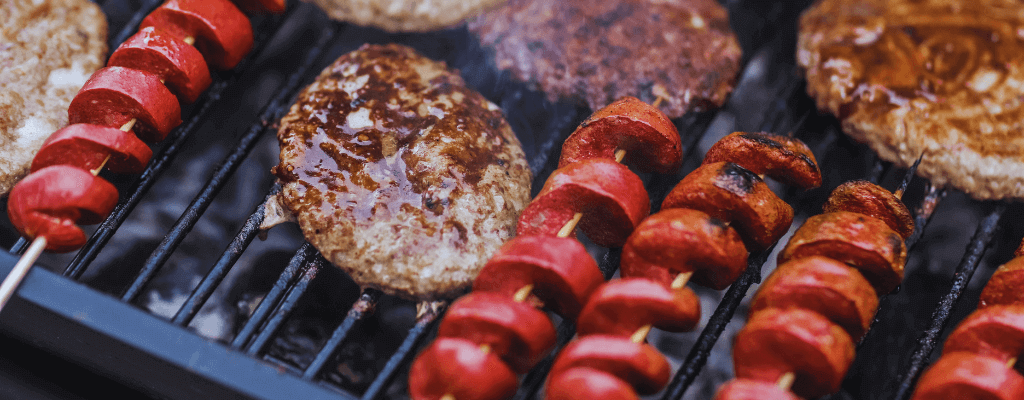
Can I Cook Frozen Burgers?
When it comes to burgers, there are two rules. For burgers that are bought frozen, you can put them on the grill or pan. Generally, frozen burgers take 18–20 minutes to cook. However, the cooking time can differ depending on the thickness of the burgers. For better results, follow the instructions given in the packaging.
On the other hand, the process is different for burgers you get fresh from the store. When you freeze fresh burger patties, you need to thaw them before cooking them. You must check if the centre is properly cooked and the burger is piping hot.
Can I Cook Frozen Eggs?
From breakfast to dinner — sweet to savoury eggs — we eat eggs in a variety of ways. But can you cook frozen eggs? The answer is not so simple. You can’t cook frozen eggs directly; you first have to defrost them.
The best way to defrost eggs is to keep them in the fridge overnight. Once they are defrosted, you can use them in scrambled eggs or cakes. However, defrosted eggs are preferred in recipes where they are cooked thoroughly.
When you freeze eggs, it is suggested that you separate the yolk and egg whites and beat them before freezing. Remember not to put whole eggs in because when eggs freeze, they expand, which can make a mess inside your fridge. Also, do not freeze hard-boiled eggs, as they get rubbery once frozen.
Can I Use Frozen Milk?
No, you can not cook frozen milk. To cook frozen milk, you first have to defrost it. Once the milk is defrosted properly and there are no icy bits left, you can use the milk in cooking. However, when milk is frozen, the fat separates and turns the milk yellowish. So, after defrosting, shake the milk, so the fat can get properly mixed with the rest of the liquid parts.
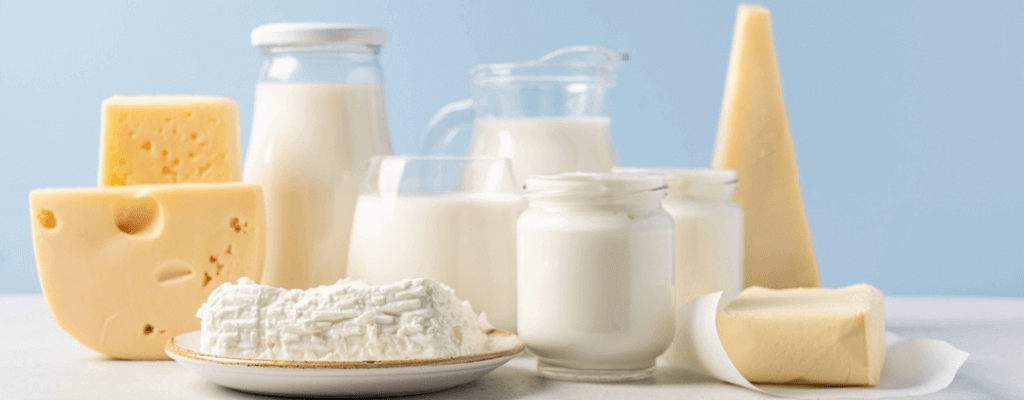
Can I Use Frozen Cheese?
Freezing cheese is a good way to store it for long. However, it may slightly change the texture and taste of the cheese. You can use frozen cheese directly if you are planning to cook it, for example, putting it on pizza or pasta. The cheese will be defrosted and melted in the cooking process.
But if you do not want to cook it, then you have to thaw the cheese. When it is completely defrosted, it is safe to consume. However, the cheese may get grainy or crumble after defrosting.
When you freeze cheese, remember only to put hard cheese. Soft cheeses like Brie or cream cheese have comparatively higher amounts of fat and water than other cheeses. Thus, they get watery once they are defrosted. So, avoid freezing such types of cheese.
Can I Cook Frozen Vegetables?
Yes, you can cook vegetables from frozen. Some people actually prefer frozen veggies to fresh ones, as fresh veggies are spoiled quickly.
You can directly toss the frozen veggies on a pan or cook them any way you like. Frozen veggies get cooked faster compared to fresh vegetables, so it reduces cooking time. Frozen vegetables can get soggy when you cook them in an oven or steamer. Thus, it is better to choose other options for cooking them.
However, not all vegetables are suitable for freezing. Some vegetables are high in water content. Thus, they become mushy when defrosted or cooked from frozen. These vegetables include cucumber, lettuce, zucchini, and more.
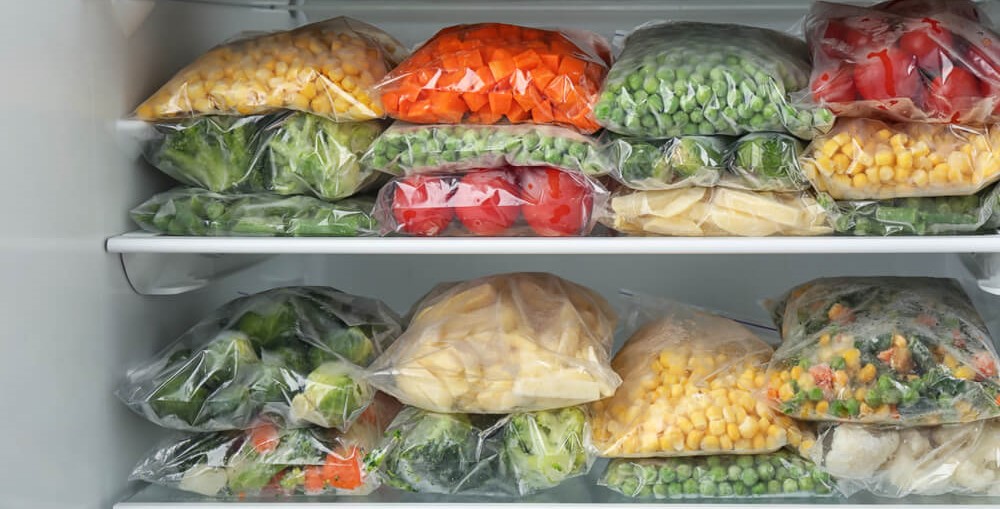
Can I Use Frozen Garlic and Onions?
Garlic and onions are the best ingredients for adding taste and dimension to a dish. Did you know you can freeze garlic and onions? Freezing these two ingredients can reduce your prep time for cooking, and it is completely safe as well.
Clean the onions and chop, mince, or dice them before freezing them in a bag or container. The same process goes for garlic. If you want, you can also blend them and freeze the purée in ice trays. After that, all you have to do is throw them in a hot pan or cook them as you like without worrying about defrosting them.
Can I Eat Frozen Bread?
Yes, you can eat frozen bread. But it’s worth noting that bread may lose its texture and taste over time. Also, eating frozen bread after its expiration date can lead to mould growth and stomach issues.
Otherwise, it’s good to eat; simply put frozen sliced bread in the toaster or grill. Follow the instructions on the label for the cooking time. If you have frozen bread dough, you have to thaw it first. Then, pop the dough in the oven to enjoy freshly baked bread.
Can I Cook Frozen Soup?

Yes, you can. Put your frozen soup in the microwave or in a pan with low heat. Cook the soup for a few minutes and stir it. This will help in breaking down the ice and create a slushy consistency. After that, increase the heat and cook until it’s boiling hot. If you find it too thick, you can add some water.
Sometimes, the taste of the frozen soup can change a bit. So, taste it and add seasoning according to your liking. When you freeze the soup, make sure you put them in separate portions and eat each portion at a time. This way, you can avoid heating the soup more than once.
Can I Eat Frozen Fruit?
Fresh fruits have a very short shelf life. Thus, frozen fruit is a good option for reducing waste and eating fruits all year round. You can cook frozen fruits directly, for example, by simmering them into a sauce. The second option is to thaw them and use them as you would fresh fruits in different recipes.
However, when you cook frozen fruits, they release more liquid than fresh fruits. Therefore, you have to make changes to the recipe and cooking time accordingly. The fruits can also get softer than usual, so there may be some changes in the texture of the recipe.

Can I Eat Frozen Pasta?
Whether it’s raw or cooked pasta, you can cook both from frozen. For raw frozen pasta, you can cook it in the same way you cook fresh pasta. The only difference is to spend an extra few minutes for the frozen pasta to cook through.
If you have leftover cooked pasta, you can put it in the oven, microwave or pan, reheat it and enjoy your pasta. When you reheat the pasta, make sure it’s piping hot. In addition, while using a pan or microwave, a splash of water will help the pasta not stick to each other. Cover the container with foil if you heat it in the oven to trap the steam and prevent the pasta from sticking.
Can I Reheat Frozen Rice?
Cooked rice that has been frozen can be cooked again. In this case, as the rice is already cooked, you have to reheat it properly. However, when you reheat the rice, ensure it is steaming hot. So, if you have leftover rice, you can put it in a sealed container or a bag and freeze it for later use. But remember, you can only reheat the rice once. If you keep it after reheating it once, bacteria can grow over time.
Can I Cook Frozen Pizza?
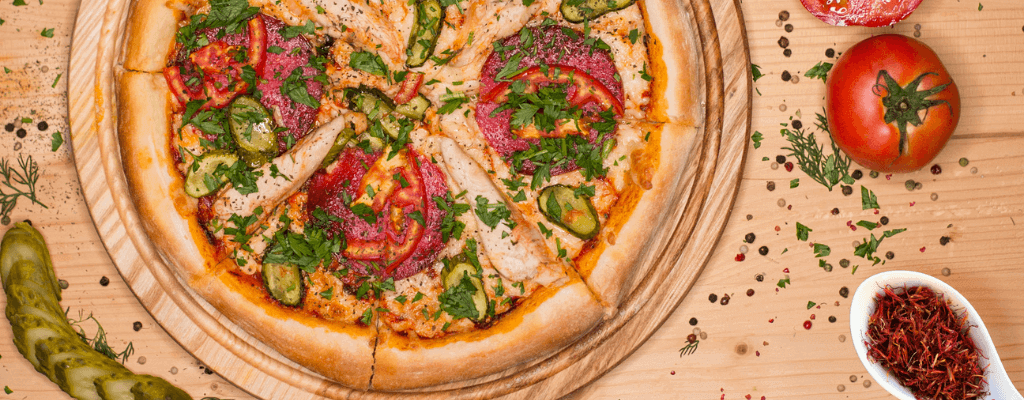
Nothing tastes better than a freshly made pizza. For that, you have to prepare the sauce, knead and rest the dough and bake it as well. But not everyone can afford to give such time or energy. This is where the frozen pizza comes from. You can buy frozen pizza from any supermarket and cook it in your oven. This is the easiest way to enjoy pizza with no hard work.
Can You Cook Foods From Frozen Using a Slow Cooker?
The slow cooker is an easy and effective way to cook delicious meals. However, when it comes to cooking frozen food, it may not be ideal. Especially for meat products, a slow cooker is not the best choice. The reason behind this is — when you cook frozen meat or other items in the slow cooker, it takes too long to reach a safe temperature.
As a result, the food stays in the danger zone (8 °C — 60 °C) for far too long.
In addition, in the slow cooker, the food may not reach the safe temperature zone. This increases the risks of harmful germs and bacteria growth. Consuming such food can lead to food poisoning and other food-borne illnesses.
Label each container or bag with the food's name and the date it was frozen.
Expert Tip! Tweet
Why Can't You Cook Some Things from Frozen?
Cooking frozen foods directly may not give you the delicious taste you’re looking for. And it might even be a safety hazard, depending on the type of food and the cooking method.
Here are a few reasons why cooking certain food from frozen isn’t recommended:
1. Uneven Cooking
Some food items can’t be cooked from frozen due to the risk of uneven cooking. When large pieces of meat are cooked from frozen, the outside may look good, but the inside stays undercooked. Also, there is a risk that the inside will not reach the safe internal temperature. As a result, harmful bacteria can survive and increase the risk of foodborne illnesses.
2. Increased Cooking Time
Frozen food takes longer to cook than fresh or thawed food. So, you may have to keep the food in the oven or stove for a long time to ensure it’s cooked. This can result in overcooking the food, and the results will not be as satisfactory.
3. Texture Changes
There are also some foods which lose their texture and taste when they are frozen, such as fruits and vegetables that possess high water content. They become slushy, and the taste deteriorates. There are also food items that are prone to splitting when they are frozen, such as egg-based and milk-based sauces and soft cheese.
4. Safety Concerns
Certain foods can have cold spots, especially if they’re dense or large. This can raise safety concerns because it will prevent the food from reaching the temperature needed to destroy for harmful bacteria. For instance, we need to maintain specific internal temperature for foods like poultry and other meat products to safely eat them.
5. Food Poisoning
While defrosting, some food may sit too long in the danger zone. It allows bacteria to flourish, which increases the risk of foodborne illnesses. For example, stir-fries or seared meats do not fare well from frozen since they’re cooked for a short time at high temperatures.
Foods You Should Never Put in the Freezer
Not all food can take the freezing process. When you defrost or thaw them after freezing, they lose their texture and taste and sometimes even get spoiled. Here is a list of food that you should not freeze.
Fruits and Vegetables with High Water Content
Fruits and vegetables that have high water content will get mushy and lose their texture. Some of these fruits and veggies are lettuce, cucumber, zucchini, watermelon, etc.
Egg-based and Milk-based Condiments
Egg-based sauces like mayonnaise and mayonnaise-based sauces can’t be frozen. Because after defrosting, the creamy texture breaks, and the liquid separates. You will also see the oil floating on top. The same goes for milk-based sauces; they separate when the ice melts and becomes runny.
Crumb-based Food
Crumb-based food does not freeze well. After being defrosted, it becomes soggy, and all the crunch that is supposed to be there is gone.
Whole Eggs and Boiled Eggs
Eggs can be frozen after separating the yolk and whites and whisking them. But did you know that you can’t freeze boiled eggs or whole eggs? If you freeze a boiled egg, it will become rubbery and inedible.
Also, if you freeze whole eggs, it will expand once they are iced and the outer shell will crack. This can become a nightmare for your freezer.
Avoid freezing high-moisture foods, such as lettuce and cucumbers, unless they will be used in cooked dishes.
Expert Tip! Tweet
How to Defrost Food Safely?
When you think about defrosting food, the easiest way that comes to mind is leaving it at room temperature. However, this can cause serious health risks as it provides the perfect environment for bacteria to grow. Thus, you should follow the proper and safe method of defrosting food. Here are the four ways you can defrost food safely.
- 1. Defrosting in Refrigerator
- 2. Defrosting in Microwave
- 3. Defrosting Food While Cooking
- 4. Defrosting Food with Cold Running Water
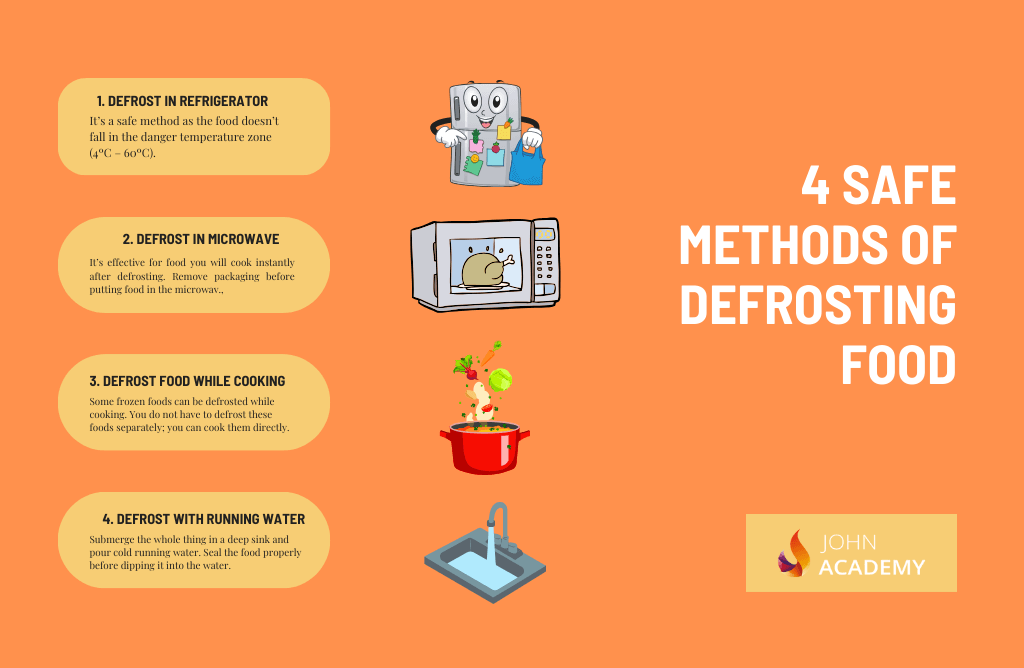
1. Defrosting in Refrigerator
Defrosting food in the refrigerator is a safe method as the food does not have to pass the danger temperature zone (4ºC – 60ºC). In order to defrost your food in the refrigerator, you have to keep the temperature below the danger zone. Also, remember to put the food on the lowest shelves or inside a bowl to prevent the liquid from dripping onto other foods.
The defrosting process in the refrigerator is time-consuming. You may need to wait hours for your food to defrost completely. So, if you are in a rush, this defrosting process may not be suitable for you.
2. Defrosting in Microwave
You can defrost your frozen food using the defrost setting in your microwave. This method is effective for food you will cook instantly after defrosting.
How to Defrost Food in a Microwave?
When you put the food in the microwave, remove any kind of packaging. Also, place the food in a microwave-proof container and cover it with the lid. Keep a small gap between the lid and the container to let the stem get out. Using a container or a bowl is important because the liquid from the frozen food can contaminate your microwave.
3. Defrosting Food While Cooking
Some frozen foods can be defrosted while cooking. You don’t have to defrost these foods separately; you can cook them directly. However, it is important to check the label and the instructions. Follow the steps given in the instructions properly to prepare the food.
4. Defrosting Food with Cold Running Water
To defrost food under running water, you have to use a deep sink or a container where you can submerge the whole thing. Also, you need to pour cold running water. Remember to seal the food properly before putting it into the water. If the juice from the food leaks, it can contaminate your sink. So, ensure the packaging is done properly and clean the sink afterwards.
In this process, there is a risk that the food will reach the dangerous temperature zone. So, make sure the whole defrosting process is complete within two hours. This will reduce the risk of staying in the danger zone too long.
What are the Risks of Incorrect Food Defrosting?
It is important to properly defrost food, as incorrect defrosting can cause serious health problems. When food is not properly defrosted, bacteria like E.coli can grow. You may experience vomiting, nausea, diarrhoea, etc.
There is also a risk of Salmonella, which can cause headaches, stomachaches and even blood with stool.
Another bacteria that can grow on these foods is Campylobacter. Diarrhoea, fever, and stomachache are some of the consequences you have to face if this goes inside your body.
Along with these, incorrect defrosting can reduce the quality and taste of the food. The food may lose colour, flavour and nutritional value as well.

How Do You Cook Frozen Food Directly or with Minimal Preparation?
Freshly cooked food may taste better, but it’s difficult to cook every single day. So, the next best option is to cook frozen meals. With minimal preparation, you can easily cook frozen food. Some food does not even require preparation; you can cook them directly. Here is how you can cook frozen food.
1. Check the Label
Cooking different types of frozen food requires different procedures. That’s why you should check the label for instructions or warnings before cooking the food. It will tell you if you should cook it directly from frozen or defrost it before you cook. You will also find on the label what temperature to cook the food or how long to cook it. So, before you start cooking, read the label and follow the directions accordingly.
2. Choose the Right Method
There are many different methods of cooking frozen food, such as baking, frying, boiling, and more. You should choose the cooking method according to the food. Here are some examples that will help you understand the right method for cooking different types of food.
3. Adjust the Seasoning
Frozen food may not taste as good as freshly cooked food. The freezing and storing process affects the seasoning of the food, and it loses a little bit of its real taste. So, when you cook frozen food, add seasoning according to your liking. However, make sure to taste it before and after seasoning, or you may overdo it.
What are the Benefits of Eating Food that has Been Cooked From Frozen?
With our busy schedule, cooking every day can be a great hassle. Thus, the next best option is to cook frozen meals. There are also many other benefits that make frozen meals a good option. These benefits are –
Tips for Safely Freezing Foods
In the case of cooking frozen food, the freezing part is as important as the cooking. So, here are some valuable tips for freezing your food safely.
1. Cool Foods Before Freezing
The first rule of freezing food is to let it cool down before you pop it in the freezer. Keep hot food in the freeze will warm up the nearby containers. As a result, they may get partially thawed and create the perfect environment for the harmful bacteria to grow. Also, as hot food takes a long time to freeze, it becomes the ideal breeding ground for germs.
So, before freezing any cooked hot meals, let it cool down.
2. Use Proper Containers
Keeping food uncovered can result in a freezer burn. But what is ‘Freezer-burn’? Freezer burn is when the water in the food escapes to the coldest area of the freezer, making the food dehydrated. This can impact the taste, texture, and quality of the food.
In addition, uncovered food can contaminate other food in your freezers, leading to foodborne illnesses. Thus, before you keep the refrigerator, wrap it or put it in a container with a tight lid.
3. Portion Foods and Freeze in Small Batches
When you freeze the food, divide it into portions suitable for one serving. This will make it easier for you to cook or reheat the food properly, and it is an effective way to avoid food waste.
4. Label Food
When the food is frozen, it is quite difficult to identify them. Therefore, label all your food before you freeze them. It will be easier and faster for you when you want to take them out.
5. Check the Date
Make sure you check the date before you cook store-bought frozen meals. If the food is expired, eating them will be a big mistake. You should also check the date on the packaging before you buy it, and if you are planning not to eat immediately, make sure there is enough time left.
Final Thoughts
Cooking frozen foods and meals allows you to enjoy versatile meals while coping with your busy life. Whether you are craving meat, vegetables, or baked goods, if you know the basic rules for cooking frozen foods, you can satisfy your cravings easily. So, use the knowledge you have gathered from our blog and whip up your favourite meals!
Take a look at our Food Hygiene, Health And Safety Course for a better understanding of what you can eat safely and how.
Frequently Asked Questions
There are many food items that you can cook from frozen. Some of them are –
- Meat
- Fruits
- Fish
- Pizza
- Steak
- Pasta
- Vegetables
This answer depends on what food you are cooking. For example, you can cook steaks, sausages, sliced meat, fish, etc, without defrosting. But you can’t cook milk or whisked eggs without defrosting. However, you may defrost food while cooking. But this will take longer to cook.
Most meat products, like chicken, beef, lamb, etc., can be cooked frozen. However, it will take longer to cook frozen meat than defrosted or fresh meat.
Yes, you can fry rice from frozen. But you need to let the rice thaw before frying.
The most common frozen foods are meat (beef, poultry), fish, pizza, sausages, steaks, burgers etc.
For many food items, it is completely fine to cook from frozen. However, not all of them can be cooked from frozen or will lose their taste. So, it is better to check if you can cook the food frozen or not beforehand.
Some foods are not appropriate for freezing. Such food items are –
- All Courses
- Health & Safety15
- IT & Development214
- Business & Management421
- Accounting & Finance61
- Photography & Video50
- Health & Fitness173
- Teaching & Academics172
- Teaching & Education2
- Intermediate,IT & Software1
- Personal Development34
- Advanced,Beginner,Intermediate,CPD Accredited,Office Productivity,Others1
- Language2
- IT, Software & Technology4
- Business10
- Marekting2
- Healthcare, Safety & Fitness6
- Therapy3
- HR and Leadership2
- Employability259
- Accounting3
- Beauty & Wellness15
- Management24
- Teach & Education1
- Project Management2
- Animal Care25
- Psychology6
- Technology1
- Finance3
- Hospitality2
- Sports3
- Lifestyle49
